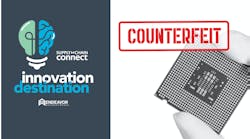Much has been written about efforts by the U.S. federal government to regulate the electronics supply chain to prevent the infiltration of counterfeit components. This increased scrutiny and regulation is especially true in military and other mission-critical industries.
The 2013 National Defense Authorization Act (NDAA) holds Department of Defense (DoD) contractors liable for counterfeit parts, implicitly encouraging buyers to source parts only from original manufacturers or franchised/authorized distributors. This regulation, and recent amendments to it, enlarges accountability not only with the government contractor, but also all the way up the supply chain to the original manufacturer, making direct traceability vital.
This direct traceability and accountability is especially critical given the increasingly global nature of the electronic components supply chain. For example, the growth of components bought by the U.S. military from non-U.S.-based manufacturers and distributors accounted for more than $2 billion of sales to the DoD from 2007 to 2011, according to research firm IHS iSuppli (see the figure).
Not only will the NDAA have ramifications for the global supply chain, but governments in countries where major buyers are located or where counterfeit components are rampant are also considering new steps they must take to continue doing business with the United States and keep counterfeits from entering their own sensitive supply chains.
The EU’s solution
The NDAA is already having a major impact on the European Union. According to IHS iSuppli, 283 EU-based manufacturers and distributors have contracts with the U.S. DoD. These contracts provided more than $1 billion in revenue in 2012, accounting for more than 50% of the department’s total revenue. The EU economy has much to lose if more stringent U.S. regulations start to hamper this trade.
The EU’s initial response has been to adopt stricter inspection guidelines via an initiative called ChipCheck. Funded by the EU’s Framework Programme for Research and Technological Development, a seven-year, €50 billion program to drive European competitiveness in global technology jobs, ChipCheck is a consortium of EU-based companies and research institutes formed to develop a new inspection system to detect counterfeit electronic components.
ChipCheck has become more of an advocacy group, launching webinars and YouTube information videos, but as yet lacks the regulatory backing that would give the project more muscle in the fight against counterfeits. And even where the EU has made regulatory headway, it is seeing those efforts circumvented by counterfeiters.
For instance, the EU’s Restrictions on Hazardous Substances (RoHS) prohibits the use of many substances such as lead and cadmium in consumer electronics products. This has led some producers of components that include these substances to falsify markings and distribute these components through the gray market, prompting further response from the EU.
Canada Takes First Steps
Canada, the United States’ largest trading partner and a leading provider of electronics technology, initially adopted a lukewarm stance to the counterfeit problem. When the U.S. Senate Committee expressed concern over counterfeits in military equipment, specifically the Lockheed Hercules transport plane, the Canadian military still purchased 17 of the planes.
“[At] this point in time, other than continuing to be vigilant, we don’t have any particular concerns in this country,” Julian Fantino, Canada’s associate defense minister, told a Canadian Broadcasting Company reporter in June 2012. In the same CBC report, the head of an Ottawa laboratory that checks military and other electronic parts for counterfeits acknowledged that counterfeit military parts in Canada are a “billion-dollar problem,” but said that Canadian industry was suffering from an “ostrich syndrome.”
Fortunately, this attitude is changing. In March 2013, the Canadian Parliament proposed the “Combating Counterfeit Products Act.” Endorsed by the Electro-Federation Canada industry group, the law calls for expanded powers to search, seize and inspect electronic products crossing the Canadian border. As of August 2013, the law was still making its way through the Canadian Parliament.
Promising signs from China
China is a well-known market for electronic components, but the Chinese government has been less than transparent in its efforts to slow the counterfeit trade. As part of the NDAA debate in the Senate, China was singled out for obstructing U.S. lawmakers’ efforts to investigate the sources for counterfeits supplied to the military, with the Chinese government going so far as to deny visas to Senate staffers hoping to travel to China to conduct their investigation.
Chinese laws are not strongly enforced, and additional pressure from the United States and other countries has not meaningfully affected the volume of counterfeits coming from that country. China is a prime example of the tension that exists in a nation when the informal economy, of which electronics counterfeiters are a part, represent such a large volume of revenue, and the government is reluctant to hinder that trade.
Fortunately in recent months, with subtle U.S. pressure, China has made some concessions. In July 2013, the country agreed to a joint operation with the United States to seize more than 243,000 counterfeit parts. China also is participating in high-level talks to reduce the quantity of counterfeits originating from within its borders.
These and other efforts have little chance of succeeding, however, if all countries involved in the highly globalized electronic components industry don’t also create and enforce regulations aimed at halting counterfeits. There have been some movements towards global cooperation, such as the World Trade Organization and Interpol partnering with industry groups such as the International Electrotechnical Commission, to develop customs watch programs and increase border enforcement.
In the absence of binding global regulations, though, the onus is on individual countries, or possibly trading blocs such as in the EU, to ensure that effective legislation and regulations are properly implemented and followed. Only then can we achieve the global objective of reducing the number of counterfeit parts in the electronics supply chain and improving transparency across borders.










